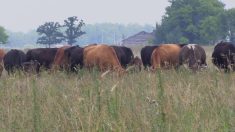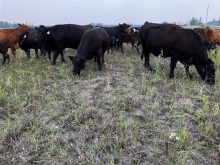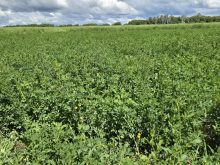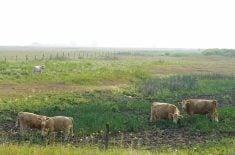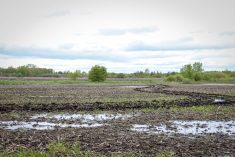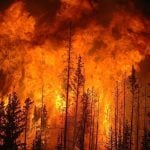As farmers settled in for the winter late last fall, agrometeorologists were already looking ahead with worry to the 2021 growing season.
After a pair of dry years, the typical fall recharge of ground moisture had failed to materialize, and they realized that the stage was being set for a major challenge the following year.
“The late fall — is the period when we typically expect the soil moisture to recharge,” Timi Ojo, agriculture meteorology specialist for Manitoba Agriculture and Resource Development told the Co-operator recently. “It’s the period when we don’t have plants growing in the field and the soil is absorbing precipitation.”
Read Also

Ag Days Gives Back 2026 focuses on fire response
Manitoba Ag Days charitable program, Ag Days Gives Back, returns for 2026 with a new wave of rural community support in Manitoba and southeast Saskatchewan
That period, and the winter snowpack and associated spring run-off, is critical for crops in Manitoba, because even in the best years, moisture is almost always a key factor in limiting yield, Ojo said.
“Even in a normal year, the amount of precipitation we receive in the growing season isn’t enough to meet crop water demand,” he said. “Wheat and canola, for example, typically have a two- to four-inch crop water deficit.”
That’s a universal truth for many things that are dependent on precipitation in the province, and it makes a drought like the one we’re currently experiencing a damaging event with long-lasting impact.
Widespread effects
This year’s drought is particularly devastating because it’s both prolonged and acute, according to Trevor Hadwen, an agroclimate specialist with Agriculture and Agri-Food Canada in Regina.
There’s been a generally dry cycle for the past several years, he explained. And that’s been aggravated by the extremely hot and extremely dry conditions this growing season which added what’s known as a ‘flash drought’ into the equation.
“Essentially what we have right now is a drought within a drought,” Hadwen said.
It’s created a situation so bad that it’s been drawing comparisons to some of the worst droughts that the region has ever seen — years like 1936, 1961 and 1988. Those are fair, albeit imperfect, comparisons, Hadwen says. But unlike some of the more recent droughts, like 1988, this one is made worse by its widespread effects.

In 1988 the drought affected Alberta, Saskatchewan and parts of Manitoba, Hadwen said. Today the effects are much more widespread.
“Everything basically from northwestern Ontario to Tofino (on the western coast of Vancouver Island) is in drought,” he said. “That makes it much more difficult to manage the effects of the drought.”
In 1988, for example, producers didn’t have to go too far afield to find feed sources, or places where they could ship their livestock to graze. But today, those options simply don’t exist.

There are other sources out there, but they won’t be easy to source. The Canadian Federation of Agriculture, for example, is trying to organize hay shipments from the Maritimes, where abundant production exists. And Hadwen personally remembers hay shipments coming in from as far afield as Texas during other very dry years.
“It’s not unprecedented, but it’s certainly not normal,” Hadwen said. “It’s very costly and the work to get it here is immense.”
Hadwen says there have been some “unprecedented” moves that have been made this year that lend some insight into the scope of the challenge. For example, the federal tax deferral program was triggered in June this year for much of Manitoba, months ahead of when a decision might have ordinarily been expected.
Long shadow
Another reason this is a drought that will be remembered it its long-lasting impacts.
It’s fuelled an epic forest fire season that’s blanketed much of Western Canada in smoke for weeks on end. Rivers and streams have run dry and soil moisture levels have fallen, season after season, as lack of rainfall, crop water demands and evapotranspiration have taken their inevitable toll.
Ojo says that here in Manitoba, that’s been an established pattern since the 2017 growing season. For much of the province, 2016 was the last year they’ve seen a ‘great dump’ of precipitation of the type of slow and steady accumulation that can recharge soil moisture.
“The 2017 season was OK — great even, in parts of the province — but that’s because it was relying on the moisture reserve from 2016,” he said. “In every year since then, we have seen the soil continue to dry down, in every successive year.”
As this pressure has built, so have the effects of the drought. Hadwen noted that typically a drought is something that’s seen as an agricultural problem here in Canada. But this year the effects are being seen far and wide and well past the farm gate.
Trees are dying back in farm shelterbelts and urban boulevards alike. Drinking water sources are under pressure in many areas. Backcountry camping has been banned in Manitoba, and fire bans blanket most of the province. A Manitoba ski hill — Holiday Mountain near La Riviere — even cancelled its upcoming season, citing lack of water to create artificial snow.
“That might not seem like much, but to me it was really telling as to how severe this drought is,” Hadwen said. “Ordinarily, there would be plenty of opportunity to get enough precipitation in the fall, but they’ve looked at the situation and come to the realization there’s no reasonable expectation they will get enough water.”
Cattle producers are probably the group that will feel the effects for the longest in the agriculture sector, once the costs are all totalled.
For example, producers are seeing long-lasting impacts on their grazing land. Many of them are diverse polycultures and during drought times some plant species all but disappear, and won’t magically reappear after a bit of rain.
“For those lands, there will be a five-year window, where there are different plant population progressions before it becomes as productive as it was before the drought,” Hadwen said. “Things take time to recover.”
Then there’s the cost of the management decisions livestock operators are forced to make. Faced with little feed and scant water supplies, they’re being forced to cull and liquidate herds, cutting into their prime breeding stock (see story on page 6). When the drought does break those producers will face the unenviable — and no doubt expensive — task of rebuilding their genetics.
Slow recovery
Just as the drought took time to build, the recovery from it won’t be an overnight event.
Ojo was at the Glenlea Research Station, south of Winnipeg, earlier this summer. He noted deep cracking going down at least 2-1/2 feet. That sort of moisture deficit will take more than a rain here and there to recover from, he said. What’s needed is the sort of deep, soaking rains that seem to have become rarer in recent years.
“The sort of rain we had in the last few days, that creates something called preferential flow in heavy clay soils,” Ojo said, speaking August 11, following about an inch of rain over the previous two days.
“It’s filling the holes that are made by the cracks, but at the end of the day, you’re not going to have uniform soaking. What we need are three, four, even five days of very good, soaking precipitation. That will fill the cracks, help the clay to swell again. Having as much rain, but over a shorter period, wouldn’t help as much.”
That sort of rain will fall, Ojo said, but it’s impossible to say when, only that the weather will, eventually, slip into a wetter cycle once again.
“At some point we’ll get through this cycle, and be back to normal — and even excess — moisture,” Ojo said. “It always goes in a cycle.”
But even when the rain does return, Western Canada will be left with the lingering effects to work through.
Hadwen says public attention tends to move on quickly after the drought, and he’s already been fielding questions about whether the drought is over because of that recent rainfall (it isn’t).
“Even when we get back-to-normal moisture and erase that water deficit, the effects will linger,” he said. “Trees still died, and won’t grow back overnight. Pastures are still damaged. Herd genetics will be gone and the cattle sector will need to build up herds again. The impacts will be long lasting from this drought.”





